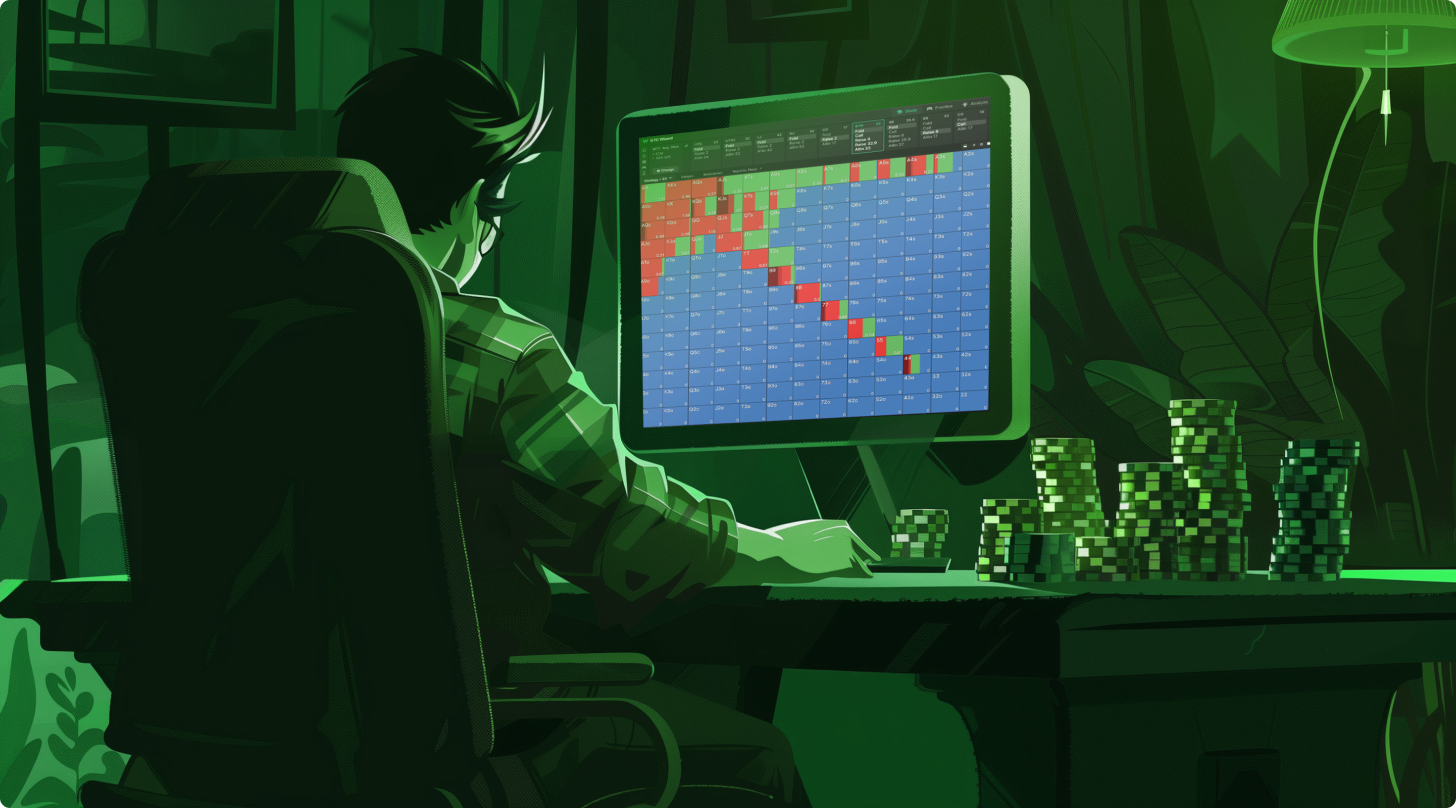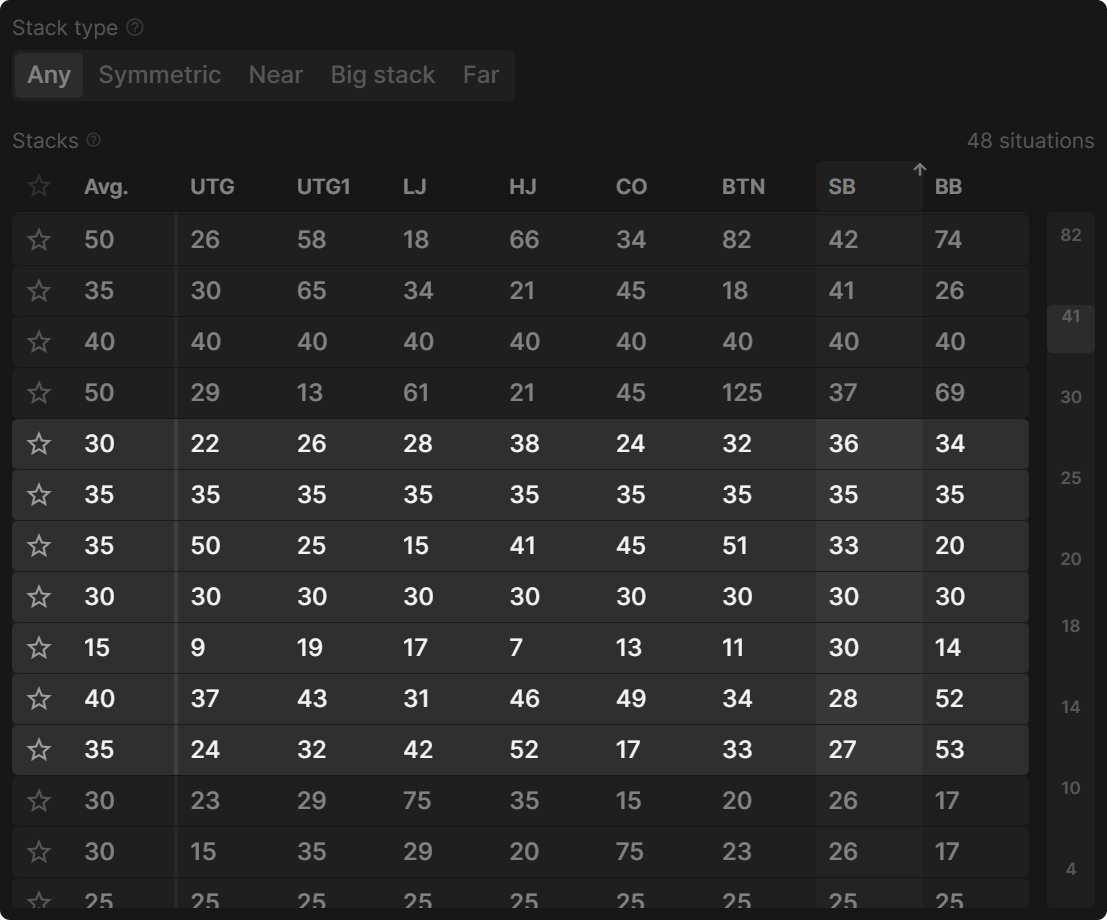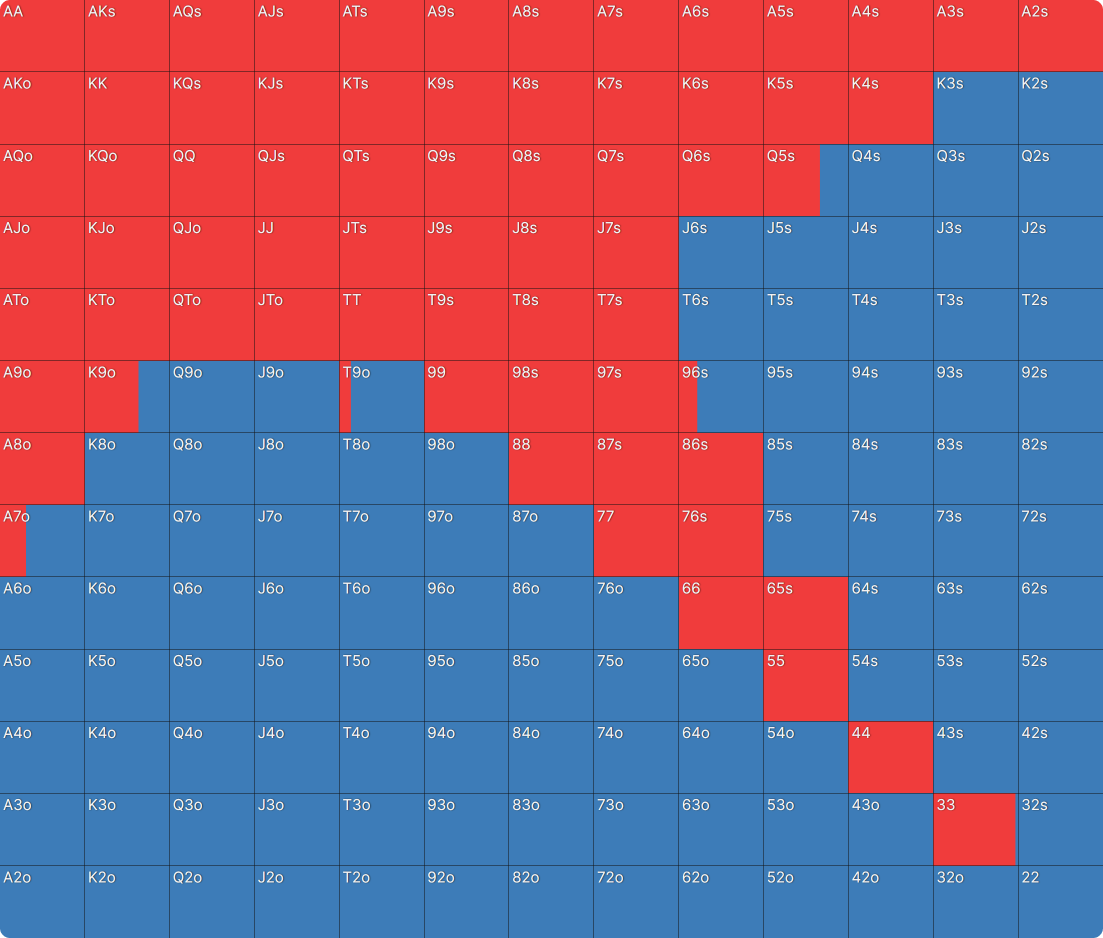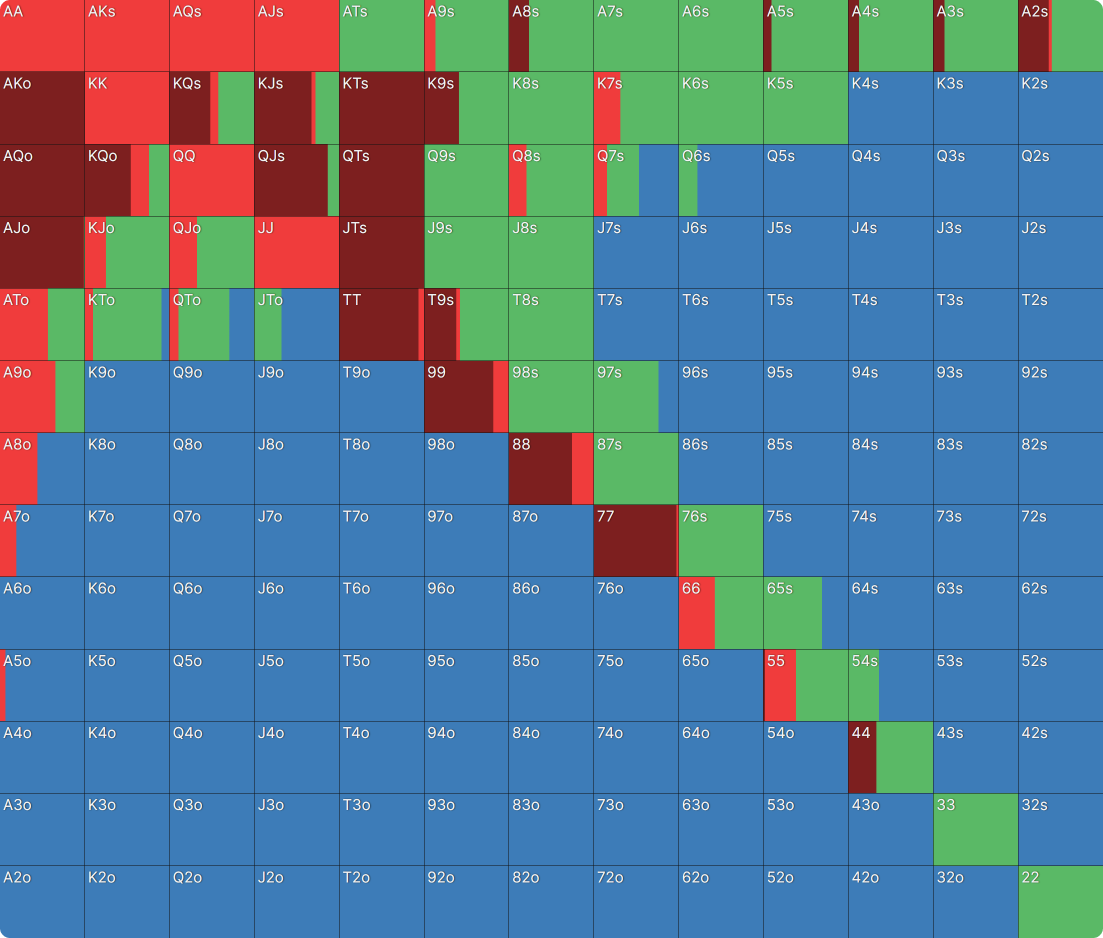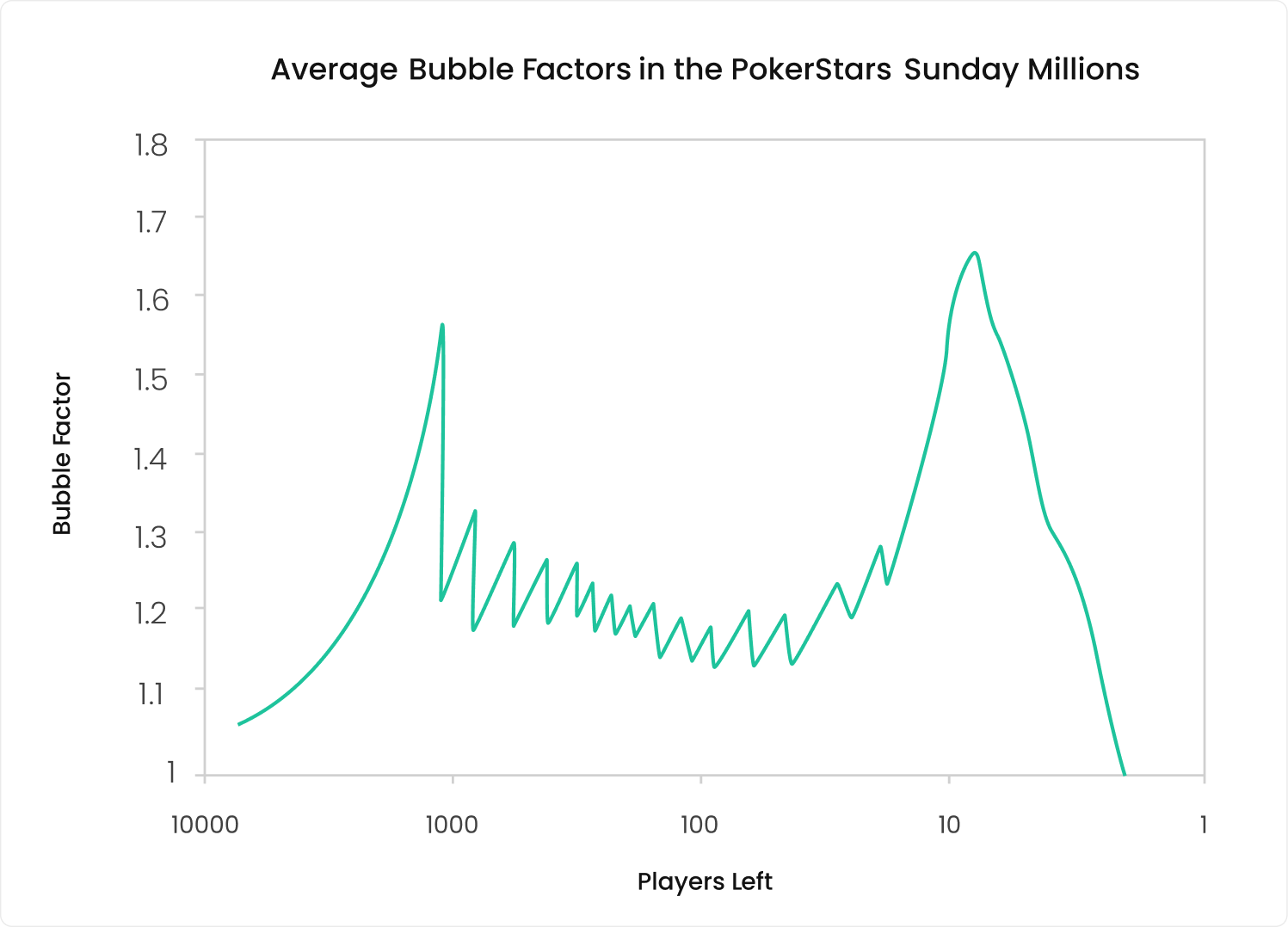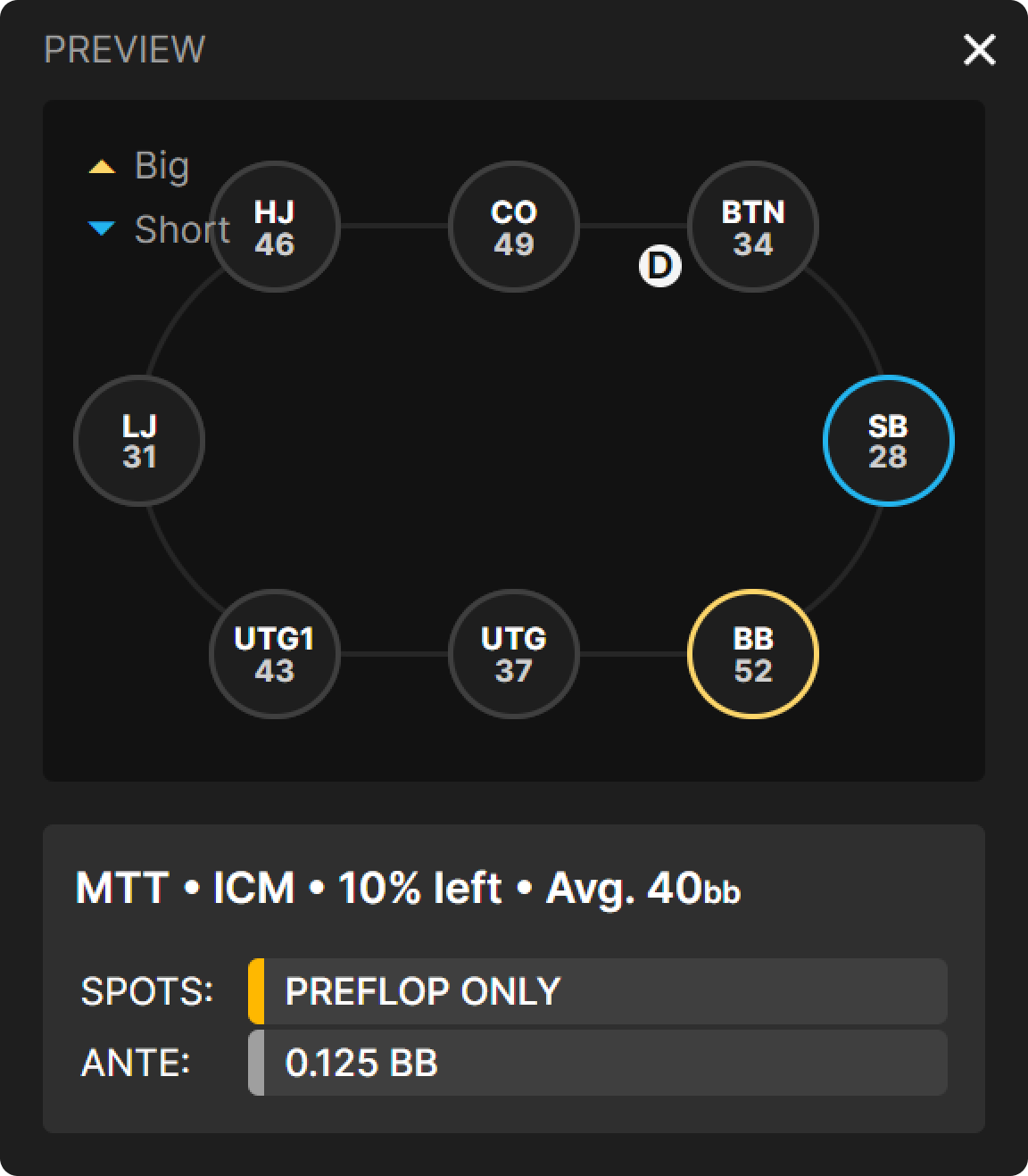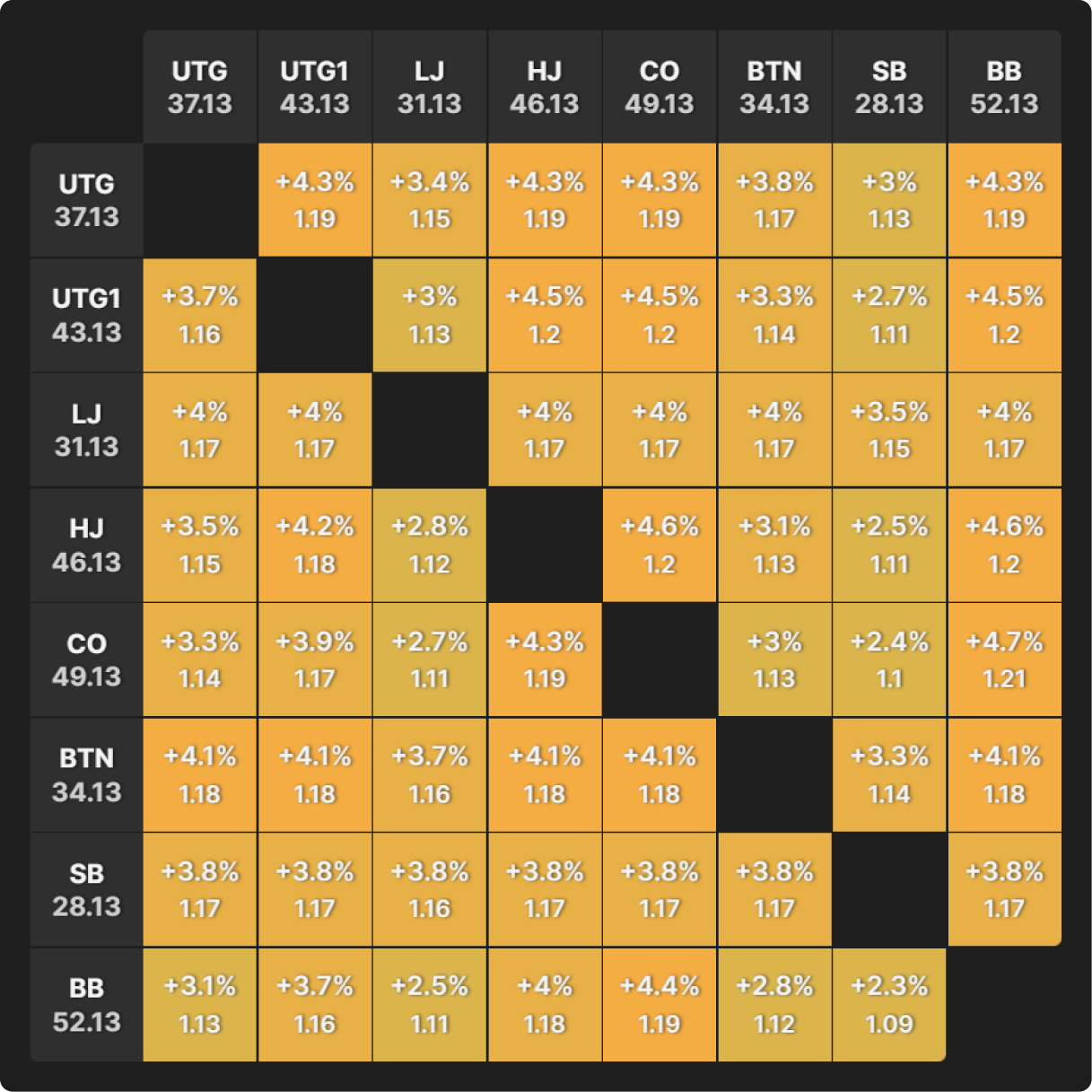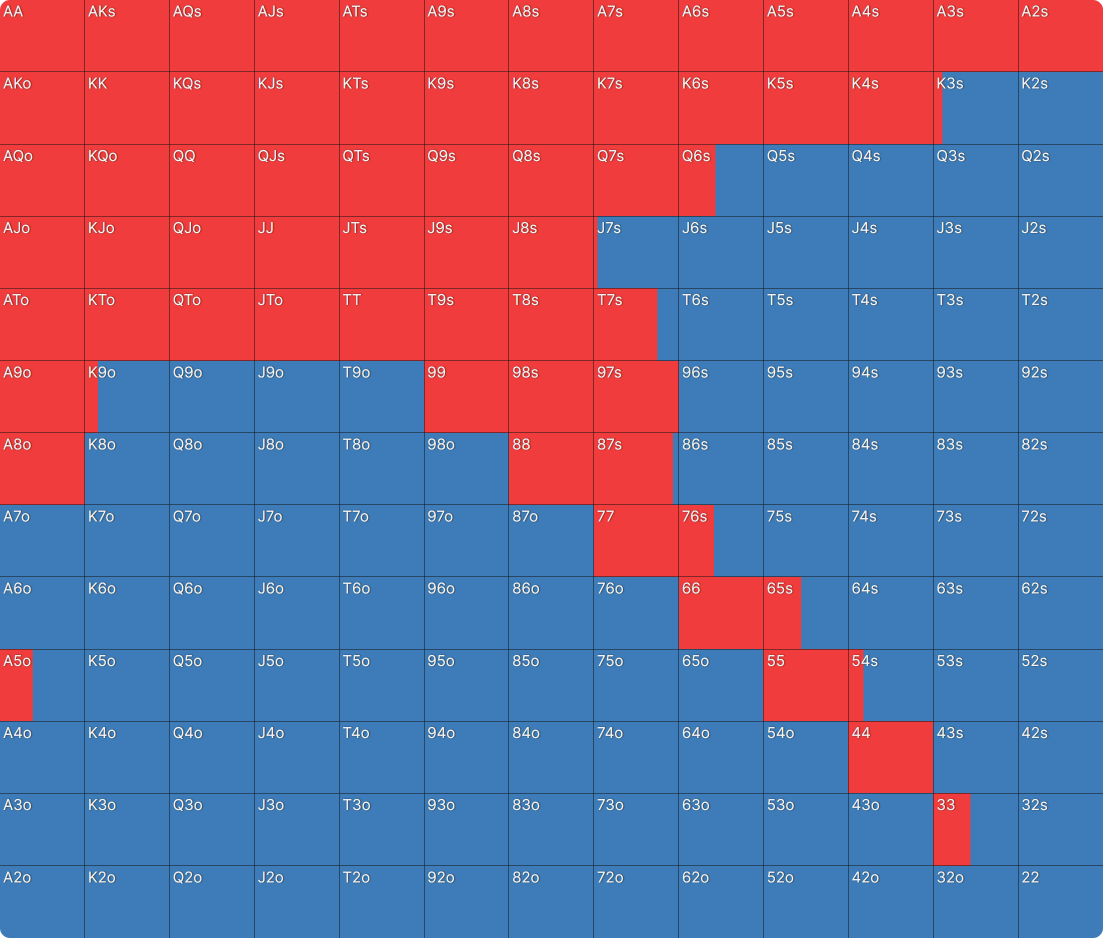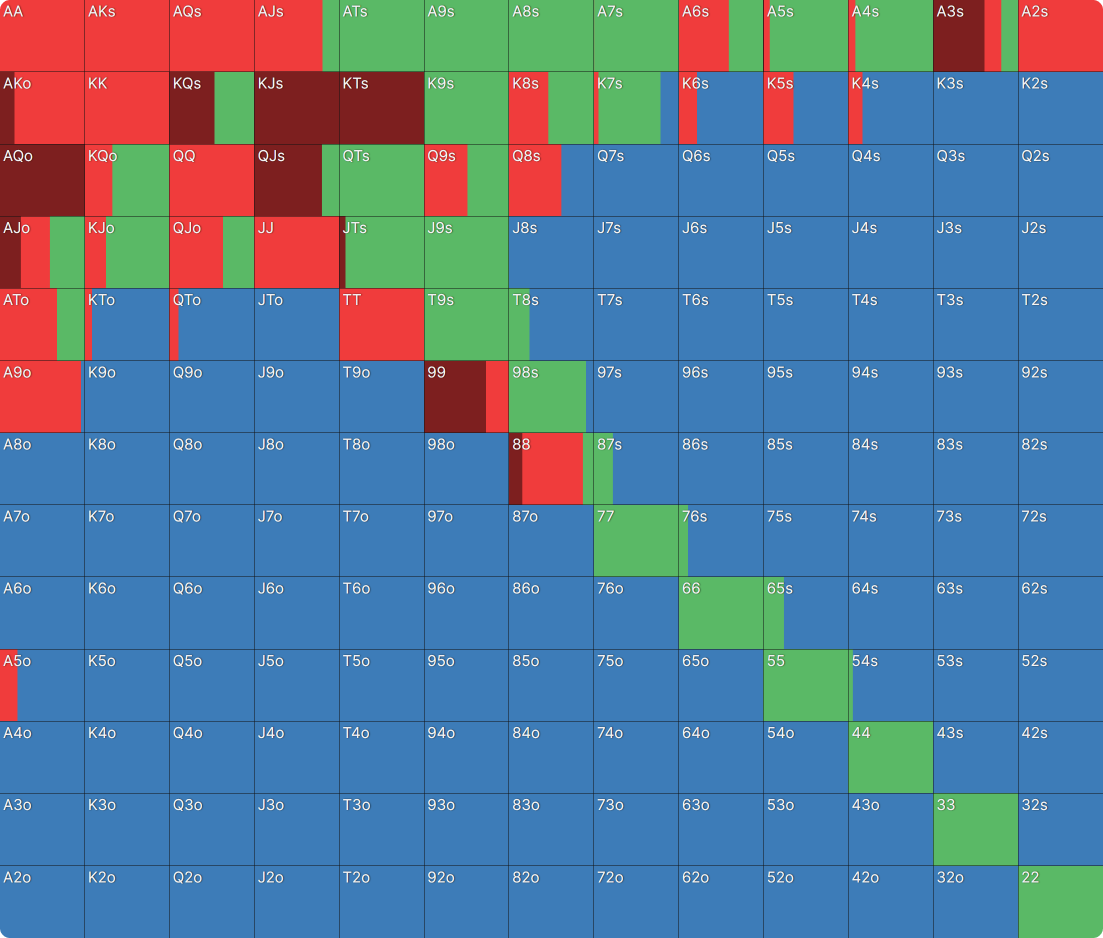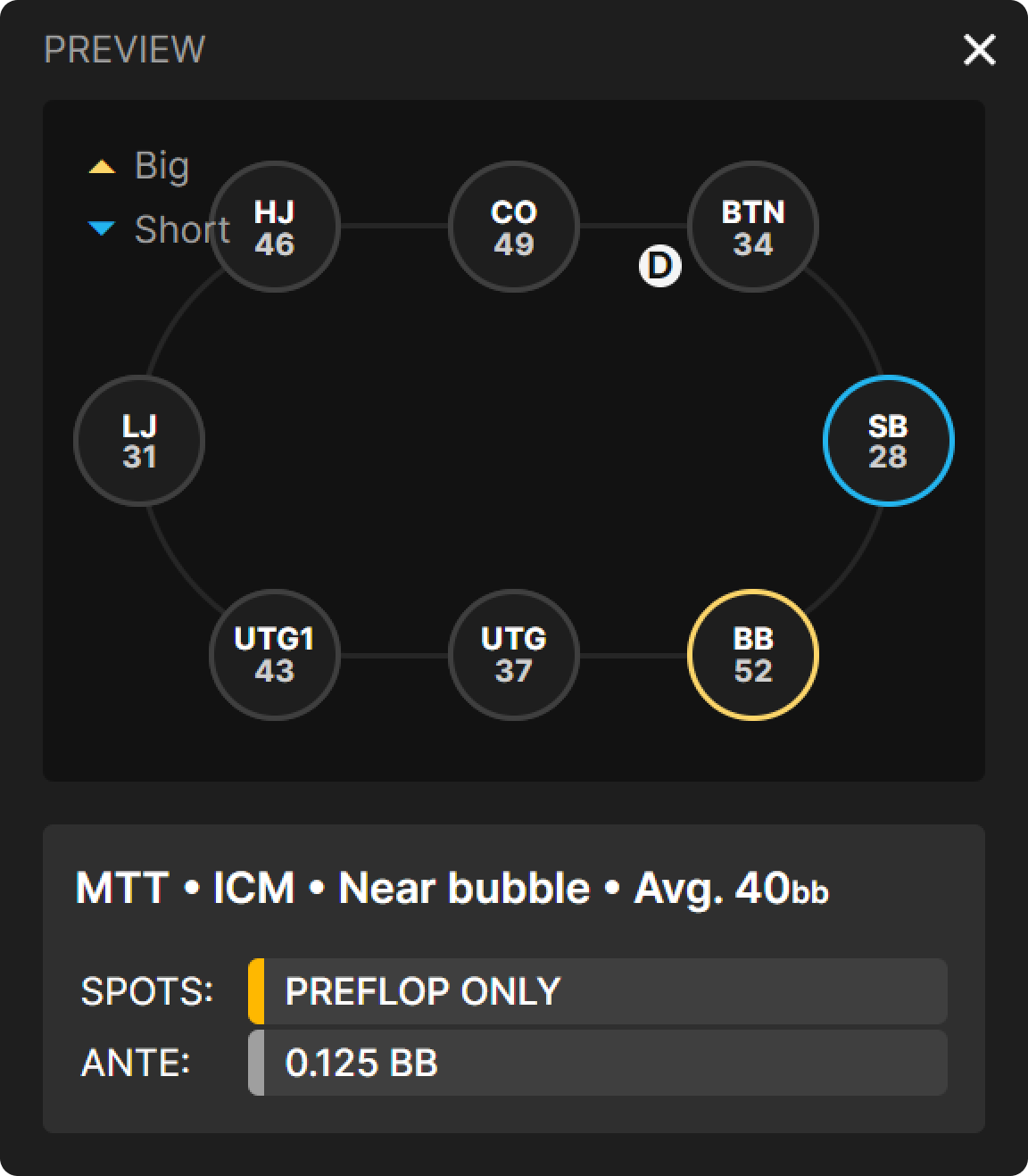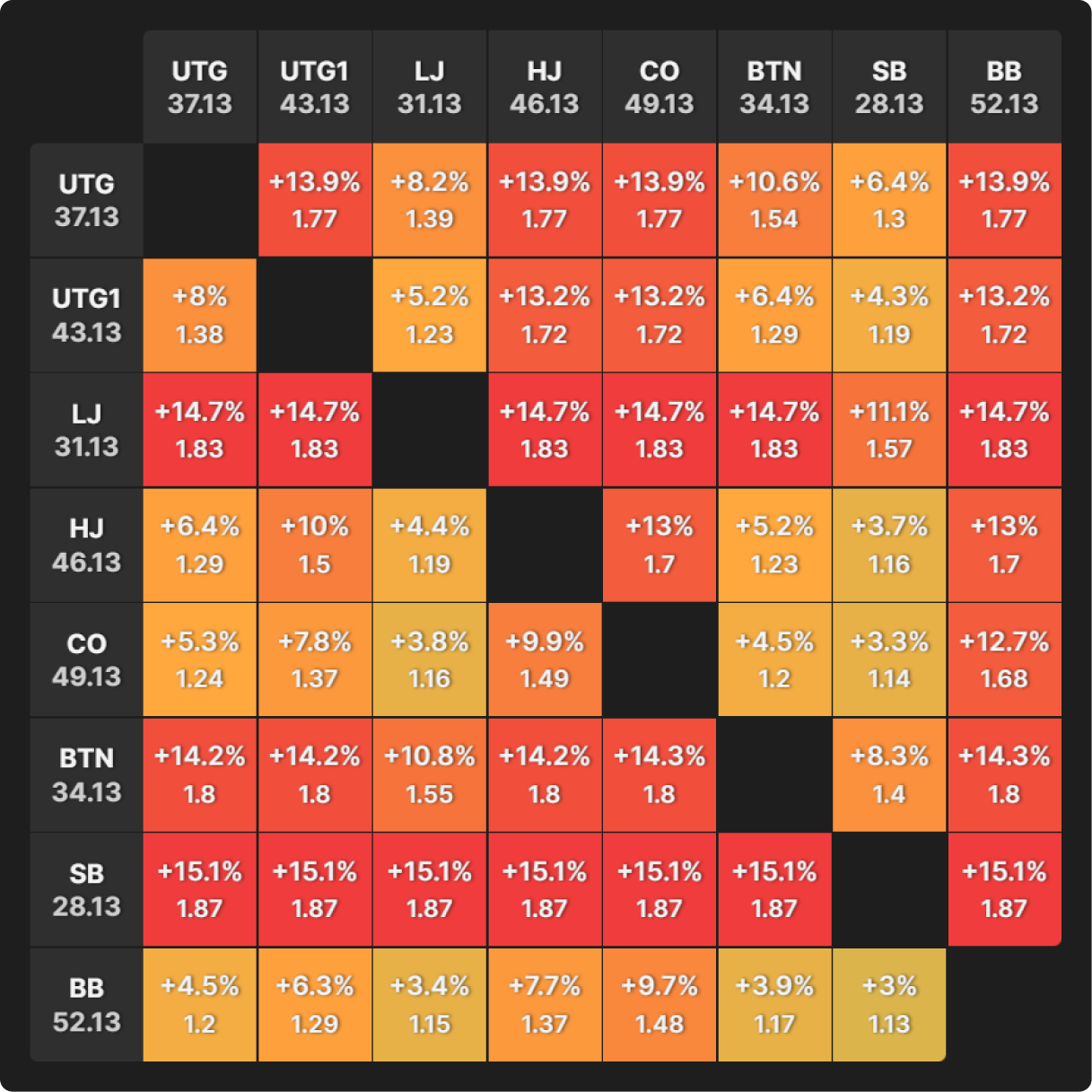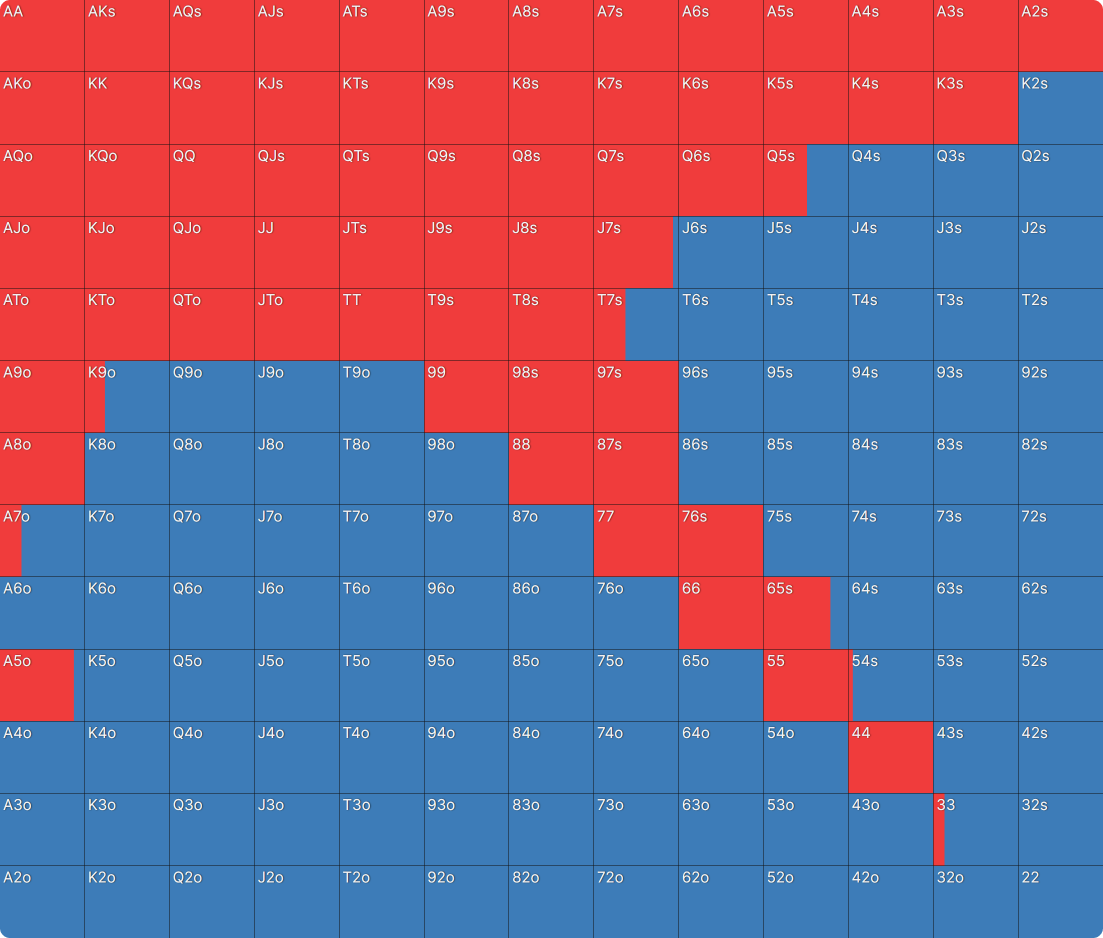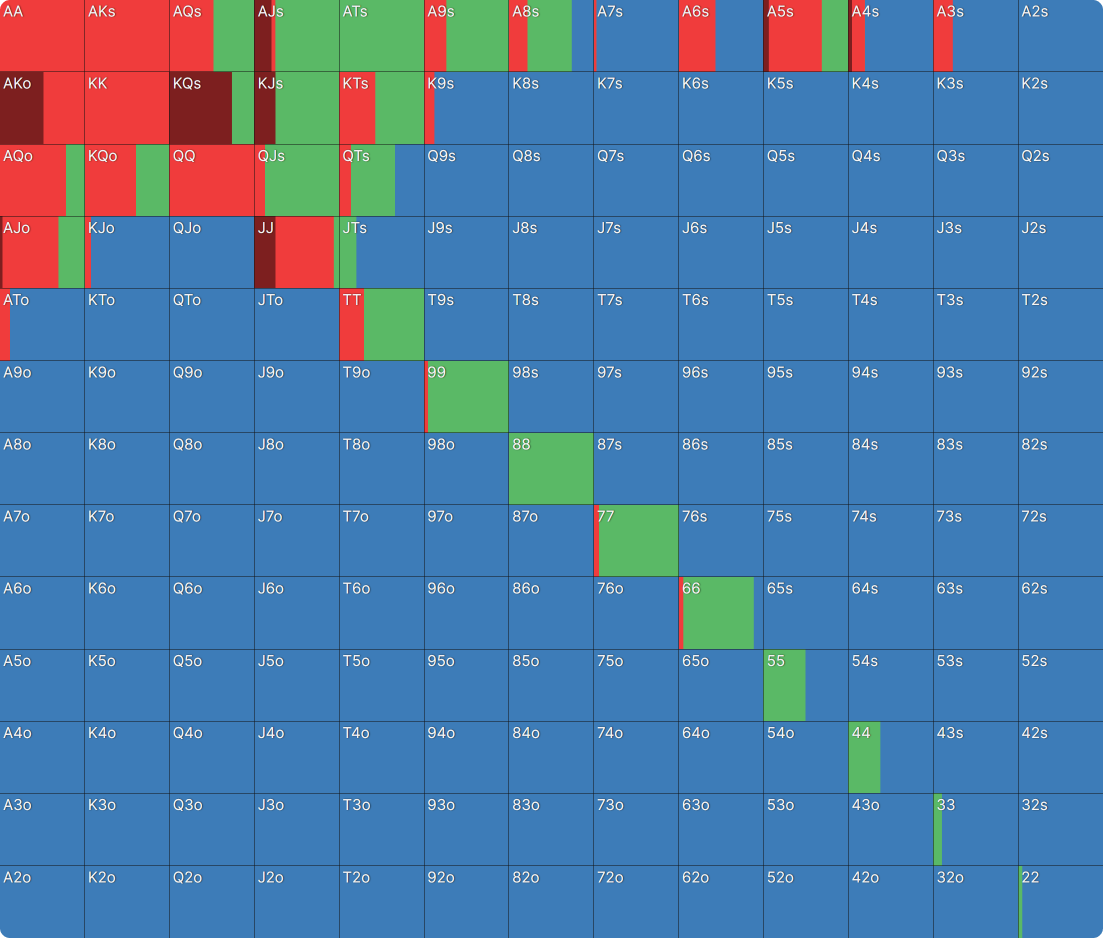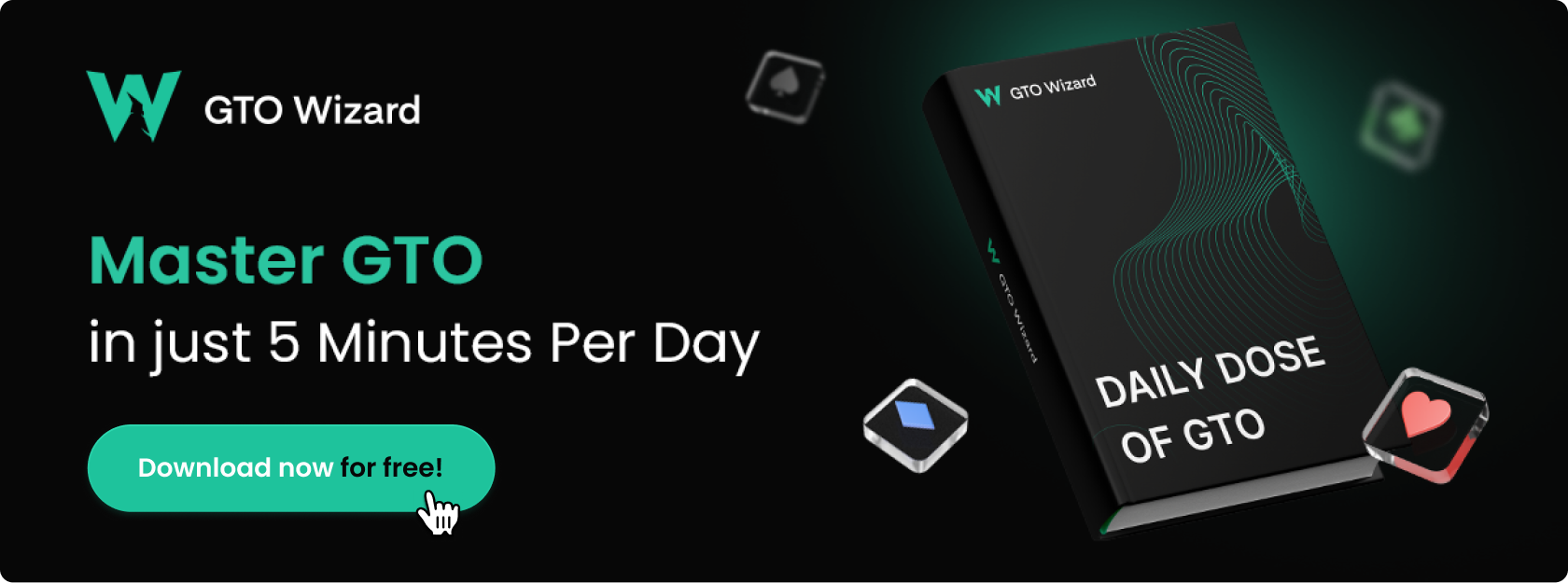How To Review ICM Preflop Ranges
In a sense, tournaments could be considered the more complex format compared to cash games. The case for that is built around the notion that there are more moving parts, especially when ICM is a significant factor. The payout structure, fluctuating stack sizes, and phase of the tournament all influence the strategy. So much so that following any one range in a cookie-cutter fashion would be foolish.
You can, however, take a lot away from the ICM solutions in the GTO Wizard solutions library. What follows is a primer on how to think about studying these preflop ICM ranges so that you extract universal lessons that can be reapplied to different but similar-looking scenarios.
Gather Data
While you cannot currently run your own custom ICM simulations from scratch in GTO Wizard, there are so many presolved spots you can study that will be close enough to hands you have already played and want to study.
Let’s jump into a hand to explore this further. Recently, I have been finding myself confused about what my SB range should look like when the effective stacks are 30bb against middle position opens when ICM is a moderate factor. So, not ITMIn the money
Any finish in a poker tournament where the player has won money for their placement. Also known as “having cashed”. Often abbreviated to ITM. bubbles or FTFinal Table
The last table remaining in a poker tournament. Often, people use the abbreviation FT to refer to it. bubbles, but when the money bubble is approaching or perhaps has burst.
Last week, I played a hand where the HJ opened, and they covered me. I had about 32bb in the SB, a little under the tournament average. The bubble had recently burst, so ICM was a factor, but the pressure coming from it had just deflated considerably. My specific hand was ATs, and I was pondering whether it played better as a call instead of a raise.
GTO Wizard AI isn’t able yet to run a simulation for this exact situation, but luckily, the solutions library houses a bunch of presolved ICM spots. All I had to do was:
- Go to the solution selector (see the “Change” button in the top-left corner)
- Pick the nearest tournament phase to mine: 10% left, big field
- Click on the SB column header to sort the SB stack sizes numerically
- Scroll to all the near 30bb spots
- I then picked out the spots where the table makeup looked the most similar to the one I played
Sometimes, there will be an extreme outlier stack that dramatically changes the strategy, but for the most part, the differences between the spots will be minor. And, as we will see later, it’s worth checking out several spots anyway.
Start With ChipEV
Ironically, the first step in the review process of any ICM spot shouldn’t involve the ICM ranges, but starts off with the ChipEV equivalent ranges and strategy.
Treat the ChipEV ranges as the ‘baseline’ strategy. You need to have an understanding of the ChipEV counterpart when you pull up the ICM ranges because it’s not possible to gauge the adjustments under ICM if we don’t know the starting point (when there’s no ICM).
So, before we look into the ICM scenarios, let’s first nail that baseline. This is HJ’s 30bb RFI range:
Quite a wide, linear range of 29.6% of the best hands, with board coverage.
This is the SB response when HJ has opened:
We raise 13.2% of hands overall, of which half is shoved. The raising range is mostly linear comprised of the strongest hands. The shoves are mostly suited Broadway hands that perform well when called, are very happy to get folds from Ace-x, and block some of the strongest calls (such as AK, KK, QQ, etc.) while unblocking a lot of folds (weak, suited high cards like A6s, K7s, etc.).
The flat-calling range is 12.7% of hands and is more of a capped range that plays quite well against a wide opening range and also plays quite well multiway (assuming the BB continues a lot) but would be in trouble if they raised and were called.
My specific holding (ATs) from the hand I queried was a flat-call, which was my initial instinct.
We will return to this shortly.
This will never fit perfectly because ChipEV solutions use effective stacks, meaning you pick the solution based on the shortest stack in the hand. As we will see, we do the opposite with ICM because the relative differences between stacks have a significant impact on the strategy and so have to be accounted for.
Inject Payout Structure and Chip Distribution
ICM solutions assume equal skill. The factors that impact strategy are the blind level, stack sizes, phase of the tournament and the payout structure. In PKO MTTs, there is another factor which is obviously the bounty.
We have already written in detail how payout structure impacts ICM. The cliff notes are that a flat payout structure will typically have an outsized tightening effect on the ranges of medium stacks especially but also the short stacks, whereas a top-heavy payout structure, by comparison, loosens the ranges. Laddering becomes more important in flat payout structures; ‘playing for the win’ is more important in top-heavy payout structures.
The presence of bounties will always have a loosening effect on ranges, though when ICM is a factor, they will still tighten up.
Who covers whom, and to what degree, has a significant impact on strategy. When a player who covers you is left to act behind you, it will tighten your strategy. When you cover a player, you can be more aggressive against them. When there is a mix of stack sizes left to act, it has a push-and-pull effect on your ranges.
The earlier in the tournament, the less ICM influences strategic decisions and the closer your strategy is to ChipEV. There is a first peak on the money bubble before ICM quickly declines. There are smaller peaks and troughs before it ramps up again at the final table bubble when ICM is most significant. It then decreases sharply with every elimination as tournament equity gets realized and the final payouts get steeper. When there are only two players left, we revert to full ChipEV.
Let’s find a spot in GTO Wizard to explore further. This is a 1,000-runner tournament with 10% of the field remaining. The bubble has burst. We are the SB with 28bb, close to the 30bb in the above example.
ICM is a factor, but we are still far from the final table. Looking at the setup here, we are the shortest stack with 28bb. The chip leader is the BB, sitting on 52bb. The HJ, who opened in our hand example, is third in chips with 46bb.
We, now, have the opportunity to make some assumptions about how the chip distribution will impact play.
First of all, the presence of the chip leader in the BB will likely have a constricting effect on everyone else’s ranges. The HJ is not only covered by the BB but also by the CO. So, my assumption here would be that the HJ will open tighter than in the ChipEV example.
In response to the tighter HJ open, and given the looming threat from the BB also affecting SB, I would assume the SB would also have to play tighter. I might also expect to see blockers playing a bigger role in the raising range, as taking pots down without showdown is good for our survival.
Get into the habit of making assumptions like this. It will give you something to test out when you analyze the ICM ranges.
Measure ICM With Bubble Factor/Risk Premium
Bubble factorBubble Factor
Bubble Factor (BF) measures how much more losing hurts than winning helps you in MTTs. It’s a measure of survival pressure and a valuable tool for understanding ICM spots. It’s defined as the ratio between how much tournament equity ($EV) you’d lose getting stacked, divided by how much $EV you’d gain stacking some player in the tournament. BF = | $EV Loss / $EV Gain | when stacks are fully invested. Each player pair has a unique bubble factor. In a chip EV scenario, the BF = 1 because losses are equal to wins. In an ICM scenario, losses hurt more than wins, so the BF > 1. In a bounty format, BF can < 1 due to the potential reward of winning bounties. and risk premiumRisk Premium
Risk Premium measures the extra risk you take stacking off in an MTT. It’s a measure of survival pressure and a valuable tool for understanding ICM spots. Risk premium is defined as the extra equity you’d need to call someone’s shove, compared to a (chip EV) pot odds calculation. RP = Required Equity (ICM) – Required Equity (cEV) when stacks are fully invested. Each player has a unique risk premium against every other player in a tournament. essentially quantify the impact of the payout structure and the chip distribution. If you’d like to first get acquainted or freshen up on this concept before continuing here, then this article is a good place for that. In short, the practical guideline is that the higher your bubble factor, the tighter your range has to be to justify stacking off.
Before you look at the ICM ranges, and after you look at the stack sizes, look at the bubble factors. This is the table containing them for our example above:
The average bubble factor is actually quite low, which was expected as the money bubble had burst, and we were nowhere near the final table (bubble). The lowest bubble factor is 1.09, and the highest is 1.2. The difference in strategy between the two would be marginal. However, ICM will have an impact.
A valuable habit to cultivate is to look at bubble factors before looking at ranges. You will develop a sense of estimating what they will be in other spots. And remember, the bubble factor is the representative of the underlying drivers of ICM strategy in solvers. So, a certain bubble factor will have the same effect on strategy independent of the environment it emerged in. It could have been the money bubble, final table bubble, a PKO, or early in a regular MTT. If the bubble factor was the same, the impact on the strategy should be the same, so the lessons transfer.
How Has ICM Impacted the Ranges?
Now, it’s finally time to look at the ranges. First up, the HJ open:
The first thing to look at is the frequency. The HJ opens 27.5% of hands in this example, and they open 29.6% in the ChipEV example. A notable but small change.
It’s not the only difference, however. It’s more informative to look at how the shape of the range has changed.
The range tightened, but some hands have been added. K3s, for example, is not included in ChipEV but now plays occasionally in this ICM environment. A7o is removed, but A5o has been added.
Let’s jump into the SB response to the open before we explore this further:
There is more folding in this spot, as expected. The bottom of the ChipEV calling range is what has been removed for the most part.
The big difference this time is that there is nowhere near as much shoving. It happens 2.9% of the time here, compared to 6.9% of the time in ChipEV.
The overall raising range is also much more polarized. We are seeing more bluff raises with hands like A2s and K5s. Hands that block calls, but can make a strong hand when called.
My actual hand (ATs) that prompted this exploration remains a call.
These observations allow us to make some assumptions about ICM, which might transfer to similar spots. They include:
- Blockers increase in value because…
- Fold equity is more important because…
- Survival gains in priority, which is why we shove less in this example
The frequencies will change significantly when ICM becomes more intense of a factor, but looking at how the shape of the range changes is the secret sauce to understanding ICM strategy.
Experiment With Different Scenarios
A slight change to the prize pool distribution, stage of the tournament, or chip distribution can significantly impact the strategy when ICM is a non-negligible factor. Currently, GTO Wizard does not have the functionality to build custom ICM sims, but it has a lot of presolved spots you can study. These include a lot of mirror spots for different stages of the tournament, where the stack sizes are the same but the phase is earlier or later.
For example, this is the same spot but near the bubble. The stack sizes are exactly the same as above, but in this example, we are at the stage where ICM is extreme.
All things being equal, we assume that play would be tighter from those at risk while the bigger stacks can take some liberties. These are the bubble factors:
If you have looked at enough of these tables, then simply looking at all that red (where it was yellow before) tells you a lot. We have bubble factors as high as 1.87 at this table, meaning everyone has to play tighter.
The shorter-stacked players have seen the bigger relative increases in their bubble factors. This is because on the money bubble, more of their tournament equity is tied up in the min-cash. Anyone with a mid-stack obviously doesn’t want to tangle with the chip leader, but generally speaking, they are less pressured on this bubble.
With that in mind, here is the HJ opening range:
This opening range is remarkably close in frequency to the ChipEV counterpart.
And SB responds as follows:
This is a much (13.8%) tighter range, with much less shoving. The raising range is very strong, and the bluffs are very blocker-heavy. The calling range is much tighter and largely comprised of hands that define themselves well postflop. It’s easy to play a hand like 55 or QTs postflop under ICM pressure; you’ve either hit or you get out of the way. Unlike hands like K7s and T8s, which were in the ChipEV range.
I’m surprised to see that, once again, my actual hand (ATs) remains a flat-call.
There are so many spots to study, including spots where bounties are at stake. You would be foolish not to experiment with these as they are just a couple of clicks away and can teach you so much.
Conclusion
Although you currently cannot build custom ICM solutions in GTO Wizard, there are enough spots in the database that you can learn lessons from, which can be carried over to other spots. To recap, the procedure I follow when reviewing a preflop ICM hand consists of the following steps:
- Pull up the ChipEV ranges to remind yourself of the baseline strategy. You will not understand how ICM adjusts ranges if you don’t understand the foundational strategy from which endgame poker deviates.
- Find an ICM spot that looks most like the one you are studying, give or take a few big blinds.
- Before viewing the ICM solution, estimate how influential ICM is and how it affects the strategies by analyzing the payouts, phase of the tournament, and stack sizes. Pay attention to who covers whom, as this informs all of the decisions. Look at the bubble factors, as this is a measure of the impact of ICM. It puts numbers on how significantly the strategies will deviate from baseline for each player when they’re up against every other player.
- When viewing the ICM ranges, the change in frequency will be the obvious metric to watch for. Covered players tend to play fewer hands, and covering players can widen their ranges. Examining how the shape of the ranges deviates from ChipEV can potentially yield more lessons.
- Finally, perfect is the enemy of good. Instead of getting bogged down into replicating your exact scenario, experiment with multiple similar scenarios to get the most from this vast database.
The BB’s incentives for calling an SB preflop raise differ from those of a cold-caller facing a raise from, say, LJ or CO. And the SB’s incentives for raising differ from those of an open-raiser in any other position.
Author
Barry Carter
Barry Carter has been a poker writer for 16 years. He is the co-author of six poker books, including The Mental Game of Poker, Endgame Poker Strategy: The ICM Book, and GTO Poker Simplified.
Wizards, you don’t want to miss out on ‘Daily Dose of GTO,’ it’s the most valuable freeroll of the year!
We Are Hiring
We are looking for remarkable individuals to join us in our quest to build the next-generation poker training ecosystem. If you are passionate, dedicated, and driven to excel, we want to hear from you. Join us in redefining how poker is being studied.
